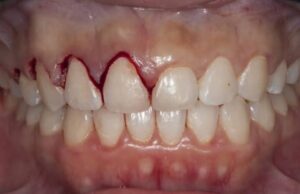
Gingival (Gums) Corrective Surgeries (Curettage, Flap, Operculectomy, Gingivectomy, etc)
Gingival corrective surgeries encompass a variety of procedures such as curettage, flap surgery, operculectomy, and gingivectomy. These treatments aim to address issues within the gums, enhancing both oral health and overall comfort. By meticulously targeting problematic areas, these surgeries ensure a healthier foundation for teeth.
These procedures can be considered for smile corrections as a part of smile design to expose a bit of more tooth and have gingival zenith in aesthetic fashion. Some of these procedures are performed to treat infected gums, such as currettage, flaps, and operculectomy.
All the procedures are done under local anesthesia, and patients are premeditated. Post-operative instructions are given, and follow-up visits are recommended.
At Oyster Dental, patient’s comfort comes first.
Gingival corrective surgeries are specialized dental procedures aimed at treating various gum-related issues, such as gum disease, overgrowth, and cosmetic concerns. These surgeries help restore gum health, improve aesthetics, and prevent further dental complications. Here are some common types of gingival corrective surgeries, including curettage, flap surgery, operculectomy, gingivectomy, and more.
Curettage
Curettage involves the removal of infected gum tissue from the tooth root surfaces. This procedure is often performed in conjunction with scaling and root planing to treat periodontal disease. By removing the diseased tissue, curetage helps reduce inflammation and promote healing.
Flap Surgery
Flap surgery, also known as PERIODONTAL FLAP SURGERY, is performed to access and clean the roots of teeth affected by advanced periodontal disease. During this procedure, the gum tissue is lifted to expose the roots and bone, allowing the dentist to remove plaque, tartar, and infected tissue. The medicaments are applied to roots, sometimes inserted between roots and gums. The gum tissue is then sutured back into place, promoting proper healing and reducing pocket depth.
Operculectomy
Operculectomy is a minor surgical procedure that involves the removal of the gum tissue covering the crown of a partially erupted tooth, such as a wisdom tooth. This procedure helps prevent infection, pain, and damage to adjacent teeth. Operculectomy is often performed when the gum tissue becomes inflamed or infected due to the partial eruption of the tooth.
Gingivectomy
Gingivectomy is a surgical procedure that involves the removal of excess gum tissue to improve the appearance of the gums and reduce periodontal pockets. This procedure is often performed using a scalpel or a laser. Laser gingivectomy offers the advantage of cauterizing the tissue, reducing bleeding and the need for stitches. Gingivectomy is commonly used to treat gum overgrowth caused by certain medications, genetic factors, or poor oral hygiene, or altered passive eruption.
Gingival Grafting
Gingival grafting, also known as gum grafting, is a procedure used to treat gum recession. During this procedure, tissue is taken from the roof of the mouth or a donor source and attached to the affected area to cover exposed roots and restore gum tissue. Gingival grafting helps prevent further recession, reduces sensitivity, and improves the appearance of the gums.
Benefits and Considerations
Gingival corrective surgeries offer several benefits, including improved oral health, reduced risk of infection, and enhanced aesthetics. These procedures help restore gum health, prevent tooth loss, and improve the overall appearance of the smile. However, it is essential to maintain good oral hygiene and follow post-operative care instructions to ensure successful healing and long-term results.
In conclusion, gingival corrective surgeries are valuable procedures in dentistry, addressing various gum-related issues and promoting oral health. By understanding the different types of surgeries and their benefits, patients can make informed decisions about their dental care and achieve optimal outcomes.